 Roberto Domingo of barangay Uhaj in Banaue, Ifugao, is among the residents enjoying the potable water system (PWS) in their barangay.
Roberto Domingo of barangay Uhaj in Banaue, Ifugao, is among the residents enjoying the potable water system (PWS) in their barangay. PRDP provides safe and accessible water to Banaue folks
Residents of barangay Uhaj in Banaue, Ifugao are now assured of enjoying a safe and accessible water after the completion of the potable water system (PWS) subproject in their barangay.
The P2.4-million Level II PWS subproject is funded and implemented under the Department of Agriculture’s Philippine Rural Development Project (DA PRDP). It has been operational for a year now, servicing around 167 households who used to rely on spring or tap to the main water transmission pipes as sources of water. It is also the first PWS completed under the PRDP in the Cordillera Administrative Region.
Helen Abluyen, 60 and a resident of Uhaj, said her family used to go to the spring to fetch water which can be reached within more or less than an hour of walking.
“When this (project) came, we are very grateful for having an easier access to potable water and people no longer argue with each other because there is enough water for everyone,” she added.
According to Engr. Edwin Camhit of the PRDP Regional Project Coordination Office – CAR (RPCO-CAR), 33 units of tap stands, two units of water reservoir, one unit of intake tank, and distribution pipelines were installed in the barangay near the residential houses and schools. Each tap stand services four to five households.
Meanwhile, residents in barangay Uhaj have benefited from the PWS subproject after its completion on March 2018, including residents from nearby barangays.
Roberto Domingo, 80 and a retired teacher, recalls the time when he and his students would walk for about one kilometer to fetch water.
“It is more convenient now that we have it here, near our house and near the school,” he said. Domingo’s household has a designated tap stand, which is shared by more than three households near him.
In the municipality of Banaue, there are three more PWS subprojects that are under implementation. With the construction of these subprojects, the local government of Banaue intends to provide a safe and accessible water supply to both farming and non-farming residents especially in the remote barangays.### (ELVY S. TAQUIO, RPCO-CAR InfoACE)
